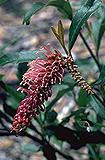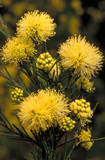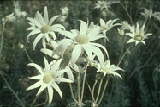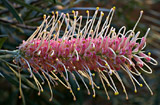|
[Front Page] [Features] [Departments] [Society Home] [Subscribe]

Short Cuts
Readers are invited to submit short items of interest about Australian plants to be included here. If submitting non-original material (eg newspaper or magazine cuttings), please also advise if the author has given permission to republish and, if not, please provide a contact address so that permission can be sought.
Short Cuts in this issue:
 The Fruit with the Stone on the Outside The Fruit with the Stone on the Outside
- Exocarpos cupressiformis - a member of the Santalaceae family, along with Sandalwoods and the Quandong.
 Observations on Grevillea wilkinsonii Observations on Grevillea wilkinsonii
- What has toothbrush flowers and smells like a mouse???
 Needs Good Drainage!!! Needs Good Drainage!!!
- The difference between a diverse native garden and a swamp is a matter of drainage!
 Serendipity in Australian Garden Design Serendipity in Australian Garden Design
- Nature's role in garden "design". Plants don't ways behave in the way we expect!
 Propagation of Hakea Propagation of Hakea
- An improved method to increase germination rates has applications to other genera as well.
 Growing Billardiera Growing Billardiera
- Want a climber that doesn't take over the garden? Try a Billardiera.
 
The Fruit with the Stone on the Outside
Parasitic plants aren't all mistletoes. Philip Milner describes a widespread species that many people don't realise is a parasite.
The tree known as the "Native Cherry" looks nothing like a cherry tree; it has more the appearance of a cypress or Casuarina but it is not related to these trees either. It is also a partial parasite on other plants but it is not a mistletoe, although it is a distant relative. Exocarpos cupressiformis is a member of the Santalaceae family, along with Sandalwoods and the Quandong, a tree of arid Australia with the edible fruits of some commercial potential. The family is widespread in temperate and tropical regions throughout the world.
There are 10 Exocarpos species in Australia and all but one is endemic. E.cupressiformis is the most widespread and obvious species. It is an understorey tree of open Eucalypt forest and woodland, often in the drier and better drained situations. If you are fortunate enough to live in a wooded area with existing Exocarpos trees, protect and keep them, and value them as they are quite beautiful and ornamental trees. You will be unlikely to re-establish them once they are gone.
In appearance it is very cypress-like, hence the specific name cupressiformis. It has many upright branches but the outer branchlets become pendulous in mature trees giving a soft graceful appearance. The branchlets are usually a yellowish-green, often with bronze toning but the actual leaves are reduced to small scales. The cream flowers are minute, in short spikes.
An unusual characteristic is that although the fruit is a globular nut about 0.5 cm in diameter, the stalk of the fruit swells, becomes succulent and turns bright red and this has led to the common name of Native Cherry. It is said to be a tasty little morsel which was much sought after by the local aboriginal tribes and the ear!y settlers and is still eaten by a number of native animals and birds. The generic name Exocarpos means -'exo' outside, and 'carpos' fruit, referring to the nut or stone being outside the fleshy part of the fruit.
 |
The red, fleshy "fruit" of Exocarpos cupressiformis is actually the swollen stalk.
Select the thumbnail image or highlighted name for a higher resolution image (35k).
|
Exocarpos is a root parasite as are many members of the Santalaceae family. The roots develop a specialized organ called a haustorium which grows out from the root and attaches by means of suckers to the roots of nearby host plants. It penetrates the roots of the host without causing damage or injury and obtains nutrients direct from the host. It uses other woody plants as hosts and not non-woody plants such as grasses or lilies. Exocarpos is not an obvious parasite and does not usually adversely affect the surrounding vegetation that it is using as hosts. This is no doubt due to its wide host range; its roots appear to attach to many trees and shrubs including eucalypts. If Exocarpos is transplanted along with an accompanying host plant it usually survives, but those transplanted without a conjoined host plant usually die within a few months.
They have great potential as ornamental plants but problems of propagation have to be overcome. Sowing fresh seed must be done with a suitable host plant. There has been limited success with stem and root cuttings. This is an ideal project for plant propagators. Native Cherry can then be grown as a specimen tree or a multi-trunked copse encouraged by a little root pruning.
From "Australian Plants", journal of the Association of Societies for Growing Australian Plants - September 1998.
[ Return to Index ]

Observations on Grevillea wilkinsonii
Discovered only about 10 years ago near Tumut in southern New South Wales, this species has a few surprises in store. Neil Marriott reports.....
Most perfumed grevilleas belong to Section Manglesia and a number of other groups primarily with white or cream flowers that have evolved to be pollinated by various insect groups.
The Toothbrush flowered group on the other hand is largely pollinated by birds, hence they often have red, orange or pink flowers with a large nectary. As birds have no sense of smell, this group of grevilleas have had no need to develop cells that produce perfume.
It was therefore of great surprise when my Grevillea wilkinsonii first flowered; the attractive pale mauve toothbrush flowers have a very strong mouse odour! This makes one speculate as to what the pollinator could be; the position and angle of the flowers on the bush i.e.terminal and reflexed slightly downward, along with the mauve colour point towards insect pollination. Yet the perfume(! !) to my way of thinking would attract native marsupial mice!
The only other Grevillea in the toothbrush group that I know to be perfumed to attract mice is Grevillea obtecta from Central Victoria. This species is prostrate with insignificant flowers which produce copious quantities of strong musky-honey scented nectar, obviously in this case to attract the marsupial mice that are common in the area. Closer observations of Grevillea wilkinsonii while in flower may provide the answer.
Whatever the pollinator of Grevillea wilkinsonii is, it is highly successful and all my plants set large quantities of seed last year. This provided several more surprises, the first of which was the tiny size of the mature follicles - only about 7mm long. Compare this with Grevillea willisii (which I consider to be one of Grevillea wilkinsonii's closest relatives) which has follicles over 10 rnm long, or Grevillea caleyii from the same group with follicles over 20mm long!
 |
Grevillea wilkinsonii is fairly typical of the "toothbrush" flowered group of grevilleas.
Select the thumbnail image or highlighted name for a higher resolution image (37k). Photo: Neil Marriott
|
Another surprise was the size and shape of the seeds. They are only about 6mm long and shaped like oval little buns with an extremely reduced eliasome* along the centre of the base. Generally grevilleas have a quite prominent eliasome to attract ants who collect the seeds and store them underground in their tunnels. Has this strategy been sacrificed by Grevillea wilkinsonii for some other dispersal strategy?
From the March 1999 issue of the newsletter of the Grevillea Study Group
* eliasome - an outgrowth on a seed containing large oil-storing cells.
[ Return to Index ]

Needs Good Drainage!!!
The term "good drainage" is not just a cliche.... If you want a lot of choice in the plants that you grow, sooner or later you will need to consider drainage. Tim Hayes explains this misunderstood concept.
When a person becomes a native plant devotee or addict it is not very long until the notion of drainage becomes an important issue. Every time we acquire a new plant, we think about drainage; indeed, we probably think about drainage before we acquire the plant. While drainage should not be an over-riding consideration, it is worth having an idea of how well-drained your garden is. Drainage depends largely on the soil type and the slope of the garden.
Soil has five principal components: Mineral particles, water, organic material (humus), microorganisms and air. It is easy to overlook the importance of the last component. The necessity of soil water to plants is well recognised but people are less likely to put air in the 'important' basket. The uptake of nutrients by plant roots is a process which requires energy and most internal processes in plants which require energy have oxygen as one of the essentials. If a plant is unable to absorb nutrients for a considerable length of time, it will not be very long before the plant begins to look sick and under nourished. Water and air take up the space left in soil by the other three components with air taking up the space left by water. Air can be forced out almost completely by excess water and this happens, of course, in very wet soil.
How wet a soil becomes after rain depends to a considerable extent on the size of the mineral particles present and on the humus. The former of these factors relates to how sandy or clayey the soil is. When clay particles are very small, the air content is proportionately less - so drainage problems tend to occur most often with clay soils. Drainage means the ability of water to move through the soil. The greater the air gaps between the mineral particles, the more easily the water can pass and the better the drainage. Drainage problems can however also occur with sandy soils - especially shallow soils with the parent bedrock close to the surface. Depressions in the bedrock can cause water to collect and this may keep the overlying soil, although sandy, wet for most of the time. Nevertheless most drainage problems probably occur with clay soils and excess water. If the level of the soil in the garden is sloping, it is unlikely that there will be drainage problems. Where the garden is level, however, and the clay content is high, there may be a problem.
 |
 |
Callistemons, melaleucas and tea trees are generally good choices when drainage is less than perfect. This is Callistemon citrinus (left) and Melaleuca nodosa (right).
Select the thumbnail image or highlighted name for a higher resolution image (30k and 38k).
|
A rule-of-thumb test for drainage is how fast it takes water to drain away from a planting hole in the soil when filled with water. If it drains off in less then a day, the drainage is regarded as being satisfactory. Clearly, this is a rough guide only. What do you do if the water takes longer to drain and you are worried by potential drainage problems? Raised beds are a time-honoured method used to solve poor drainage. This may involve adding soil to what is already there. Experience has shown that raising levels by as little as 20 cm can give many plants an opportunity to grow well. Digging into level clay will do little to alleviate a drainage problem. If the clay can be broken up completely, improvement can result. Creation of trenches that are then filled with stones or gravel is probably not something the average gardener would consider. Installation of drainage pipes would achieve a similar result. The addition of gypsum to clay can help to break it up.
The aeration properties of earthworms are well-recognised although they might need some coaxing and inducements to commence habitation in heavy clay soils. If all else fails, a person could decide to stick to (no pun intended) clay-loving species.
From the newsletter of the Southern Tablelands Group of the Australian Plants Society.
[ Return to Index ]

Serendipity in Australian Garden Design
Serendipity: the faculty of making fortunate discoveries of things you were not looking for. Diana Snape considers the concept in relation to garden design.......
Garden design is a complicated business! It's difficult enough deciding where to place plants at any given time, but trying to foresee the future growth and configuration and the resulting evolution of the garden is amazingly challenging. There is no way we can plan with absolute certainty. A Grevillea species may be listed as growing between one and two metres, with similar spread. That sounds helpful and encouraging but it's still quite a size range and the results can be very different. Significant factors include the general health of the plant and its root system, its provenance, the soil type, moisture content, amount of fertiliser provided, climate or microclimate, actual situation of the plant in the garden, and possibly its neighbours. The rate of growth as well as the final size will depend on a number of agents over some of which we have very little control. Serendipity plays its part.
We do have control over some important things, for example how much we prune. For many species some pruning is essential, or at least beneficial. Each time we prune we are making design decisions - we can be gentle or savage, prune to accentuate the natural shape or to change it considerably, to keep a plant compact or deliberately make it sparse. We can convert a large shrub such as an Acacia, a Banksia or a Callistemon into an attractive small tree. Some plants respond well to formal shaping, even topiary - for example, a number of westringias, Darwinia citriodora, dwarf forms of Baeckea virgata.
In general we continually respond to the garden picture the plants present to us. Occasionally plants do die, a negative result which still presents a positive opportunity to change the 'feel' or emphasis of an area, maybe to introduce a new plant unavailable when the garden was first designed. One disappointing result may be a decision that a plant no longer looks attractive or 'belongs' where it is - we can try moving it to a different situation, or be brave-hearted and take it out altogether.
Most outcomes are happier than this and often involve serendipity. A plant may grow perfectly just as we envisaged it. A number of species are likely to self seed, so we may have seedlings which we can leave where they appear, transplant to a chosen spot, or remove. Sometimes such seedlings may almost remind us of weeds. Others such as Crowea exalata, Flannel Flowers (Actinotus helianthi) or some correas and grevilleas are likely to be welcome. There's something very appealing about discovering little seedlings which have decided they like your garden.
 |
Flannel flowers Actinotus helianthi (left top) will often self seed in sandy soils. Like many grevilleas, Grevillea "Misty Pink" (left bottom) also self seeds but rarely comes true to type.....flowers of seedlings may be completely cream through to deep pink.
Select the thumbnail image or highlighted name for a higher resolution image (24k and 48k).
|
 |
Success with a batch of cuttings can give us a large number of plants to use for repetition in a certain area or throughout the garden. If a particular combination of plants really appeals to us, we might take advantage of its unexpected success and repeat it either nearby or at a distance. A plant may grow in an unusual way - tall, lean and upright, or leaning at an angle, or else low and spreading close to the ground. In each case we have a choice of doing nothing and letting the plant do its own thing, or trying to persuade the plant to fit in with our initial picture, possibly by severe pruning. Out of two plants growing side by side, one may be rather small and weak while its neighbour flourishes. Should we do something about that?
All such choices are part of garden design. It is ongoing, never finished. A section of the garden may be looking beautiful, but we still might decide to add another small plant which just sets it off. I think many of us tend to start off concentrating on larger plants - trees and shrubs - and gradually introduce smaller plants. such as groundcovers, herbs and 'tufties', to complete the picture. Studying garden design helps equip us to enjoy serendipity to make better choices and create gardens which give great pleasure.
From the November 1999 issue of the newsletter of the Garden Design Study Group
[ Return to Index ]

Propagation of Hakea
Frustrated at poor germination rates using traditional seed raising methods, Paul Kennedy sought a better way....
The normal method of propagating hakeas from seed by placing the seed in well drained propagating mix has not always proved to be highly successful, especially for inland and Western Australian hakeas. Germination times can vary from seven to sixty days. The northern species can be quite temperamental in that day and night air temperatures will affect the germination of seed.
I have put one seed to a tube to try and alleviate the loss of a plant through the process of potting-on the seedling. Even then I still had considerable losses due to damping off. As seed of many of the lesser known hakeas is difficult to obtain at the best of times, the need to find a much more successful method of germinating hakea seed was of great importance.
Trials using Hakea seed placed between paper toweling and kept moist on a saucer placed inside a closed plastic bread bag have proved to be highly successful. The plastic bags are placed clear of direct sunlight. This method resulted in a 95% success rate for viable seed as against 5% using the old method. Species such as Hakea arborescens, H.actites and H.rhombales have germinated in seven to fourteen days. Western Australian species have been slower, but the fact that you can inspect the progress of the seed germination in a real plus. As soon as the first pair of green leaves start pushing off the seed capsule and roots are 20mm plus in length, it is time to pot into a tube.

|
Germinating seed on moist paper in a closed container
is a similar method to that described by Paul
|
I try and leave some of the paper toweling wrapped around the root of the seedling when planting into a tube as this supplies some added moisture whilst the seedling is settling down. The tubes are placed in an enclosed cold frame which gets watered once a day by an overhead misting system.
From "Growing Australian", the newsletter of the Australian Plants Society (Victoria)
[ Return to Index ]

Growing Billardiera
A report on the cultivation of species of Billardiera at Maranoa Gardens, Balwyn, Victoria by Lisa Booth
Billardiera bicolor - spindly growth on a fence with northerly aspect. After two and a half years the plant has climbed to the top of the fence and along the top-you can barely see that the fence is there. When planted with nothing to climb on it forms a little bush as it grows in on itself. This bushy plant is 30 cm high by 45 cm and is growing in dappled shade. The plants are very prone to scale and to aphids on new growth.
Billardiera drummondiana. We have been unsuccessful with several plants of the variety collina of this species. All died within six months of planting. All were planted in clay loam, mulched with 12 mm gravel screenings, along a wire mesh fence on a north-facing slope. Inadequate drainage and heavy soil may have been the problem.
Billardiera erubescens. One plant had poor growth and eventually died when planted on a fence in dappled shade under established eucalypts. Growth was sparse and spindly. However, another plant had excellent growth on north-facing slope in full sun. In 2½ years this plant has formed a dense cover on a wire mesh fence (2 m high) and flowers for most of the year. This plant is in a similar position to the B.drummondiana which died, but is higher up the slope. It has covered the fence to a width of 2 m. Unfortunately, the dense growth provides cover for thrip and aphids, particularly on the lush new growth.
Billardiera ringens is growing in a similar position to B.erubescens, with similar results, but growth is slower overall.
Billardiera variifolia is slow growing relative to B.erubescens and B.ringens, growing in a similar position. It seems prone to twine in on itself instead of climbing on the fence. Plants are growing in clayey loam, sand, and in a clayey bed suspected of Phytophthora cinnamomi infection, equally happily. All are in full sun. No pest problems have been observed.
Billardiera cymosa is growing quite well in heavy soil in dappled shade under trees. It is a reasonable fence cover. In one year it has reached the top of the fence and is spreading.
Billardiera scandens is a good fence cover in dappled shade. A plant has covered a 2 m high wire mesh fence to a width of 0.5 m in one year. There are no pest problems as yet. It is growing in heavy soil with no problems.
Generally, we are happy with our efforts in growing Billardiera, except for B.drummondiana. B.erubescens and B.ringens have done particularly well as fence covers. They all seem hardy and require little care, except for occasional problems with sucking pests.
All except B.cymosa are flowering now, in May, and seem to have a flower or two at most times of the year.
From "Australian Plants", journal of the Association of Societies for Growing Australian Plants, March 1990 issue.

[Front Page] [Features] [Departments] [Society Home] [Subscribe]
Australian Plants online - June 2000
Association of Societies for Growing Australian Plants
|